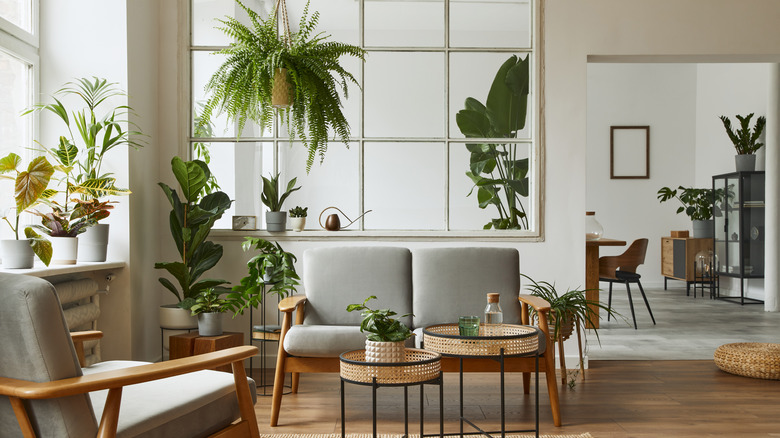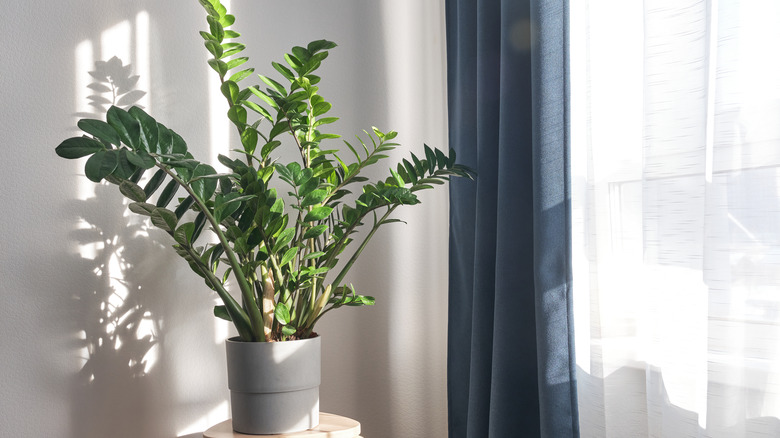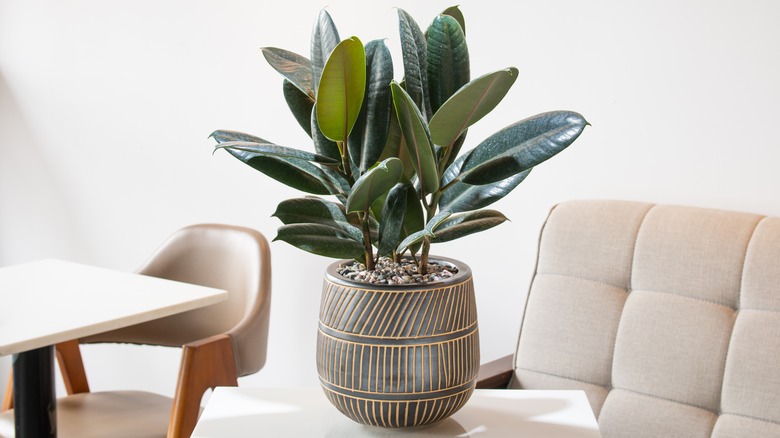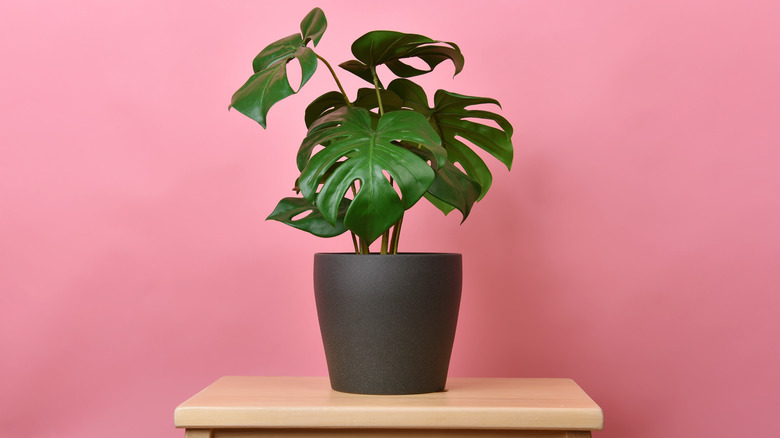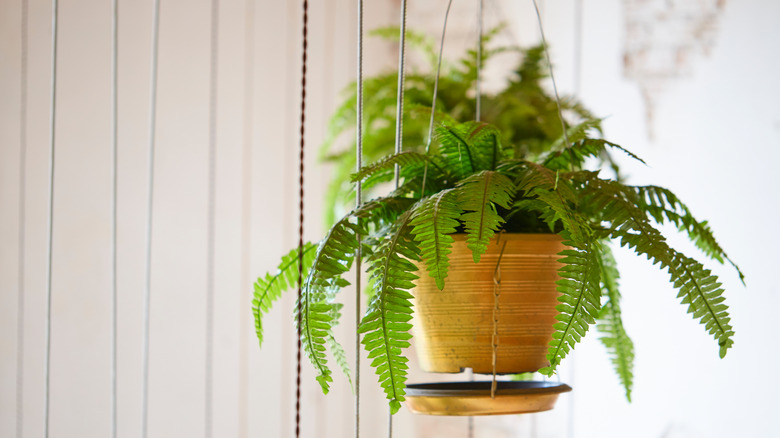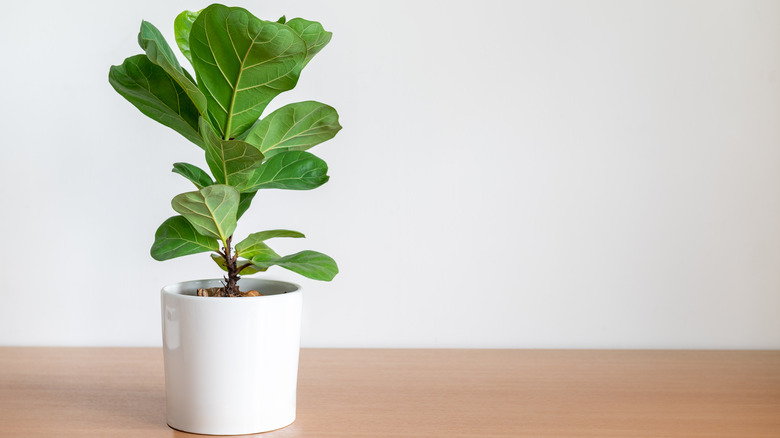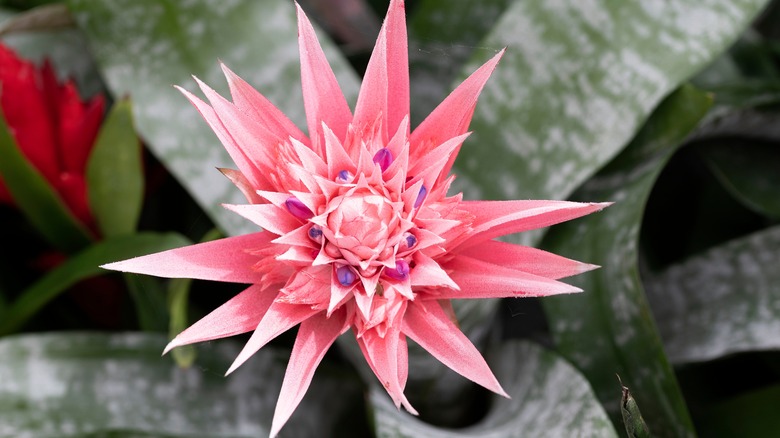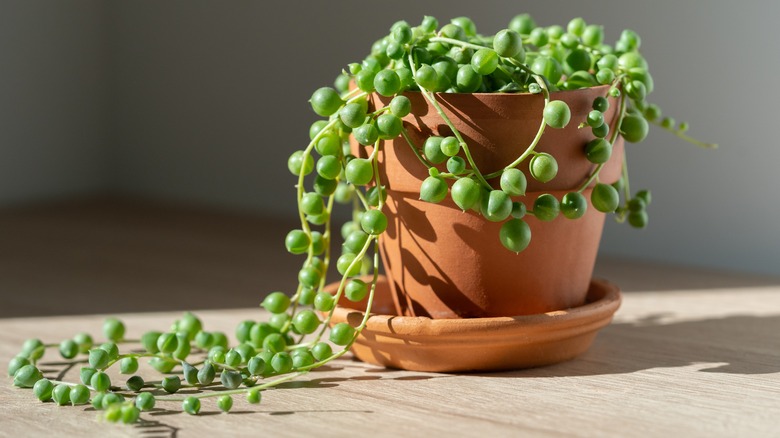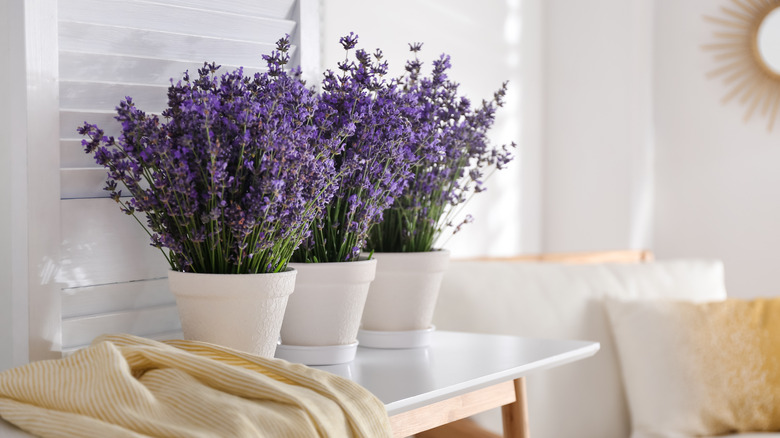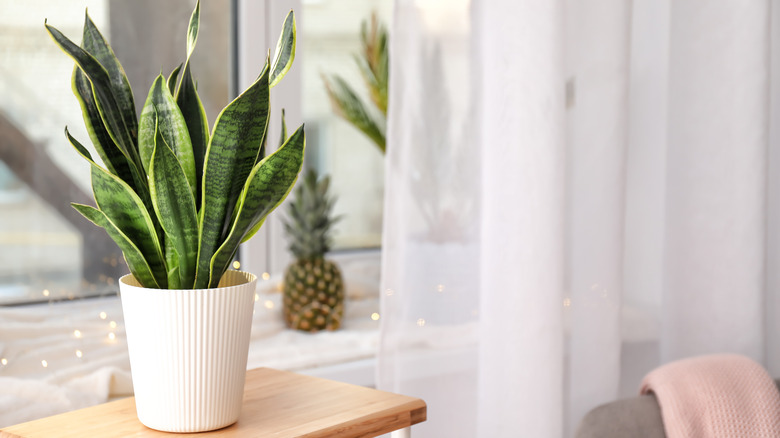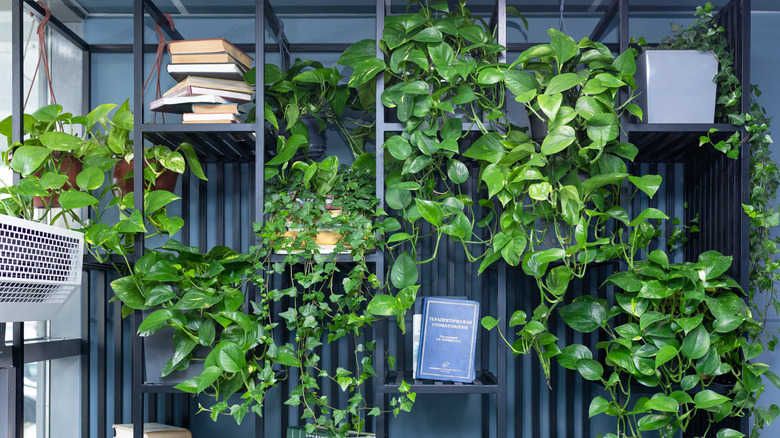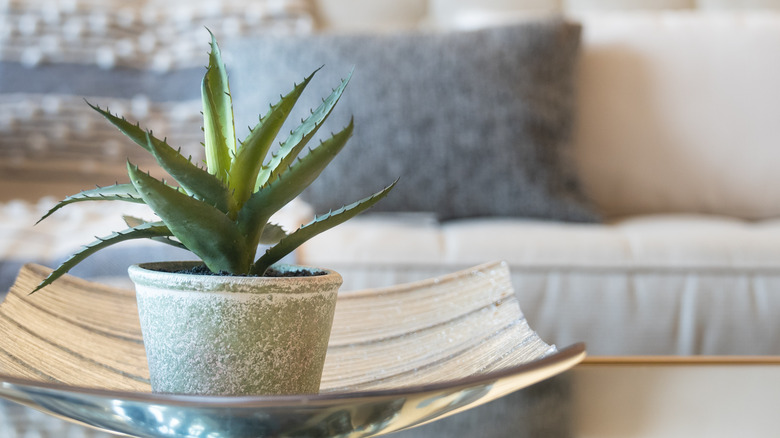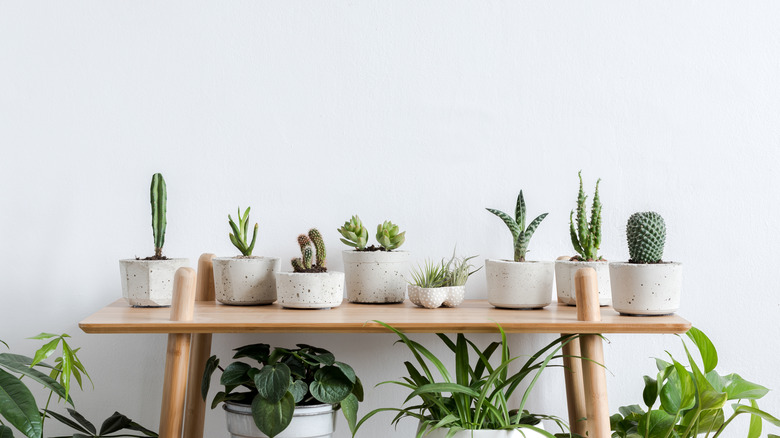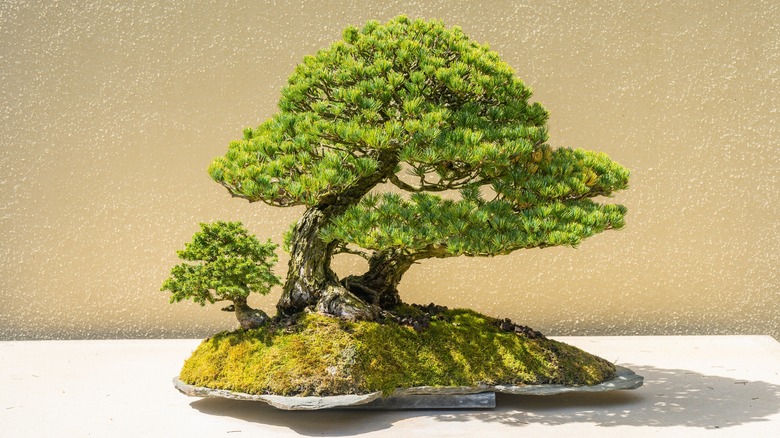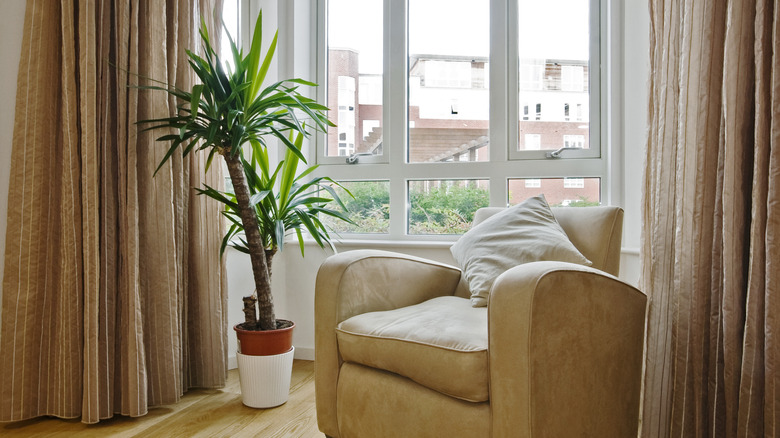Aesthetic Indoor Plants That Will Upgrade Your Home Style
When it comes to home aesthetic considerations, everyone's a bit different. You might be a maximalist whose dream living room is the indoor jungle vibe featured on every home decor Instagram page: packed with plants, cozy boho rugs, and colorful art. Maybe you're such a minimalist that anything "extra" is instantly overwhelming. Maybe you're somewhere in between, or your style is ever-changing. Regardless of where you fall on the home decor spectrum, there's one aesthetic consideration anyone can incorporate to make a home instantly warmer without sacrificing personal style: indoor plants.
What's cozier than a room full of living, breathing houseplants? Few things, in our opinion. In addition to being instantly eye-catching, incorporating indoor plants into your decor can have numerous health benefits (for example, having houseplants has been linked to better home air filtration and lower stress levels). But when you're thinking about bringing home some plant babies for the first time, you might feel like a first-time parent; that is, you'll have lots of questions. How much sunlight do they need? What if I overwater them? Will they like it best in a window or the corner? Moreover, where will they look the best? What happens if my cat starts chewing on the leaves?
If your plant search seems a little daunting, you're not alone — countless plant parents before you started as plant newbies, and they're doing just fine. We're going to break down 14 eye-catching aesthetic indoor plants you can incorporate into your space today.
ZZ plant
ZZ plants top our list of aesthetic indoor plants not only because of their stunning, light-reflecting waxy leaves but also because they're incredibly easy plants for beginners since they're so easy to care for. This east African plant can grow fairly tall, and it's easy to propagate, so we wouldn't be surprised if you have some in every room down the road!
If you're at all into feng shui, you might already know that the ZZ plant has also been dubbed the "fortune plant," as it's said to attract wealth. If you want to maximize this good-luck potential, Petal Republic recommends placing the plant in the east or southeast corner of your home. The ZZ plant doesn't love a lot of bright, direct light, though, so if you place your plant here make sure any light that comes in doesn't shine directly on the plant. Don't worry, as even a bit of filtered sunlight will still reflect off the leaves beautifully as long as you remember to dust them every once in a while.
While other plants can be picky, maintaining your ZZ plant won't be much of a headache at all. All they need is some potting soil, indirect light, and a nice drink of water when you think about it (but not too often!). ZZ plants are toxic, though, so keep them away from your kids and pets.
Rubber plant
Rubber "plants" might more accurately be called rubber "trees," as they can grow pretty large (8 to 10 feet indoors, according to Bob Vila), and they're one of our favorite ways to bring the outdoors in. Rubber plants are notable for their gorgeous hues of maroon and dark green, and the variegation common to their leaves. Depending on the variety you get, you could end up with leaves that have splotches of pink or even cream — perfect if you want to add a little pop of color or a calming neutral to your space.
Rubber plants enjoy the southern parts of your home. We think they look best in the corner of a room next to a window with a sheer curtain, as this will give them the filtered light they love. Placing a large rubber plant somewhere more inconspicuous, like a corner, will allow them to shine without being an overwhelming focal point of your space. They're also pretty good at telling you when they need to be taken care of; in general, though, place them in a spot where they can get bright, indirect light, and water them as you feel the soil starting to dry out. These plants should also be kept away from curious pets.
Monstera plant
The monstera plant has been affectionately nicknamed the "swiss cheese" plant due to its split leaves, which is one reason they're such a popular aesthetic choice among indoor plant owners. Their leaves can get quite large, making this plant easily the focal point of any room, so we recommend keeping larger monstera along the perimeter of a room. Smaller monstera or your monstera propagations look stunning on a north-facing windowsill or on a side table where they can get a decent amount of indirect light.
Monstera are also easy to grow, and they can grow fast! Planterina notes that you can somewhat control the growth of your monstera depending on how much light you give it — lower light levels will result in slower growth, while bright, indirect light could have them growing faster than you can say "propagate." As your monstera begins to grow, you'll want to tie them to a stake (or, for aesthetic considerations, consider using a piece of bamboo) so they don't droop under the weight of their heavy leaves.
Monstera plants prefer bright, indirect light and moist soil. Let the soil dry out before watering when it's cold, and water slightly more often in warmer weather. They'd also like not to be chewed on by pets, as they're mildly toxic.
Boston fern
If you don't have any plants in your shower, that's a train you should have hopped on, like, yesterday. To turn your shower into the greenery-filled oasis we're sure you've seen while scrolling Instagram, we'd recommend starting with the pretty low-key Boston fern.
Boston ferns appreciate bright light, but make sure it doesn't shine directly on them, as this could dry out their leaves. The University of Wisconsin-Madison Horticulture Division recommends the kind of medium-bright light that typically comes through an east window in your home. You can transfer them outside when the weather is warmer, but bring them in as soon as the temperature starts to fall to the 40 to 50 degrees Fahrenheit range.
Boston ferns are also big fans of humidity, so bathrooms are perfect homes for them. In fact, we love how they look hanging from a bathroom ceiling. As they grow, their leaves will start to cascade over the side of their pot, giving incredible weeping willow-esque forest vibes. Their bright green leaves also tend to not have much variegation, so if you're looking for a more uniform greenery look in a neutral space, they'll work perfectly. They're non-toxic to cats and dogs, though, so feel free to place yours wherever you'd like.
Fiddle leaf fig
Fiddle leaf figs are a little more persnickety, but they're worth it when you consider everything they can add to a space. Their wavy leaves are great for adding textural variety to a space, and they don't have much variegation in color. A single fiddle leaf fig would do an excellent job at making a minimalist home instantly cozier while maintaining the space's streamlined aesthetic. We also love how they match more eclectic design aesthetics — think lots of pattern, color, and fun furniture — without feeling too busy or out of place.
Fiddle leaf figs' large, bright green leaves love lots of bright sunlight. In terms of watering, they're slightly pickier than most other plants on this list and don't love being too wet or too dry. The Home Depot recommends watering your fiddle leaf fig lightly throughout the week and fertilizing it monthly in the warmer months and just a couple of times throughout the winter. When taken care of well, they can grow big enough to impress even the most cynical houseguest. This is another toxic plant, though, so don't let your pets or kids nibble on the leaves.
Silver vase plant
If you want your visitors to be greeted by a flowering plant that looks straight out of a sci-fi movie, the silver vase plant should be at the top of your list. It produces a spiky pink flower in the spring that will be eye-catching no matter where you keep it, and luckily for you, this is a houseplant that actually prefers being partially shaded.
Your silver vase plant will visually benefit from being around other houseplants. Its light silver leaves provide a striking contrast when placed near darker-leaved plants, like a rubber tree. Pairing it with a plant whose leaves are texturally different, like the fiddle leaf fig, will keep your space from feeling too crowded. The main attraction of the silver vase plant is the bright pink flower it produces in the spring — however, each plant will only flower once! To keep the magic of your silver vase plant alive, Brainy Gardener recommends potting the "offsets" that start to appear after your plant has flowered. These can be grown into another silver vase plant that will eventually flower. Ah, the circle of life.
In terms of regular care, the silver vase plant likes to be kept in partial shade. Keep the soil moist but not too wet, and keep the plant's central "reservoir" (a small opening in the middle of the leaf growth) mostly full of water. This plant is non-toxic, so place it wherever you'd like without worrying about nosy pets and kids.
String of pearls
It's not hard to see how the string of pearls plant got its name when you look at it. The round, green buds of this succulent look impressive whether you see them dripping off a bookshelf or cascading from the ceiling. We love to prop them on the corners of high kitchen cabinets and fireplace mantles or hang them from the ceilings of small rooms to add visual interest without overwhelming the space.
This may come as a surprise if you've only seen the string of pearls in its bud state, but this plant actually flowers in the summer. The flowers are pretty understated and look similar to white, fluffy dandelion fuzz. What's more surprising than the flowers themselves, though, is their fragrant smell of cinnamon.
As a succulent, they're pretty easy to take care of; just make sure to water them when the soil is completely dry, and give them a home in bright, indirect light. The University of Wisconsin-Madison Horticulture Division recommends giving your string of pearls a well-draining potting mixture so they don't suffer from root rot. They are toxic, but we think they look best up high and out of your pets' reach anyway.
Lavender
Lavender might not be the first thing you think of when it comes to aesthetic indoor plants, but we think it should be. After all, the wellness benefits of lavender are numerous — who hasn't used scented lavender products to act as a sleep aid? Plus, lavender oil can help ease inflammation and stress and can even ease stomach aches.
In terms of visual appeal, lavender is incredibly versatile. It doesn't grow too quickly or too large, making it a great smaller accent piece in a room that boasts some of your bigger plant babes. We think its gorgeous, fragrant purple buds serve as the perfect accent to any kitchen window, but we also love how it looks on a light wood bedside table.
Lavender loves getting a few hours of direct sunlight daily — HGTV recommends giving it a home in a south-facing window — and doesn't like too much water, so make sure to give the soil a bit of time to dry between waterings. Even though lavender is great for humans, it's not great for pets, so keep it out of reach of your pets.
Snake plant
You'll see snake plants on every list of good houseplants because of how incredibly easy they are to care for. It's also not hard to find a suitable space for them in your home, as they'll add visual interest to any room. They make a great floor plant as their leaves grow taller; while they're still small, give them a little bit of height with a plant stand (or even place them on a side table) to make them stand out. Keep them away from similar-looking plants with stiff leaves, like rubber plants, aloe vera, or cacti. Instead, we suggest populating your snake plant's room with plants of contrasting color and texture (think fiddle leaf figs or string of pearls) to keep the visual interest alive.
As we already mentioned, snake plants are some of the easiest indoor plants to care for. Just make sure they're in a very well-draining potting mixture, don't water them too often, and don't keep them in a closet (though they're really not very picky about how much light they receive). According to Gardening Know How, snake plants are also easy to propagate; simply cut off a leaf and place it in water until it grows roots before planting it in soil. Their variegated leaves can grow fairly tall, making them an instant eye-catcher, but you will want to keep them away from curious pets.
Devil's ivy
If you don't love devil's ivy for the name alone, it'll be love at first sight when you see its (sometimes variegated) leaves cascading from a hanging pot. You'll fall even more in love when you see your devil's ivy thrive with minimal care. Just give it some indirect sunlight and water it before the soil is bone dry — about once every one to two weeks, depending on the season.
As a type of ivy, Gardener's World notes that this indoor plant can grow along a pole or wires. This makes its placement opportunities almost endless. If you're going for a more streamlined interior design look, you could keep it simple by hanging your devil's ivy from the ceiling. If you really want to chase the indoor jungle aesthetic, you might try training it to climb along a pole (or multiple poles or wires) mounted along a wall or ceiling. Regardless of where you choose to put it, we recommend keeping your devil's ivy up high not only to capitalize on the hanging plant vibes but also to keep this toxic plant out of reach of kids and pets.
Aloe vera
In case you missed it, yes, you can grow the sunburn-relieving plant in your very own home. Aloe plants produce incredibly thick, long aloe-filled leaves that look stunning in a window that gets plenty of sunlight. If you're feeling particularly ambitious with your indoor greenery, you can even try to get your aloe plant to flower, which is tricky (but still possible) to do indoors. If you want to try for aloe flowers, Almanac.com recommends giving your plant as much sunlight as possible and keeping its environment above 60 degrees Fahrenheit. You should also make sure your plant isn't getting too much water, especially as you head into the cooler months.
This succulent is fairly low-maintenance, though it does like more light than most of the other houseplants on this list (it thrives best in bright sunlight). Water it when the soil dries out and you'll end up with a lovely window plant that you can use in a pinch to help lessen acne scarring or pain from burns. The juicy leaves aren't good for pets, though, so keep them out of reach.
Cacti
When it comes to cacti, your options are nearly endless as far as aesthetics go; after all, they come in all shapes, sizes, and even colors. They're easy to maintain as long as they get plenty of light and water when their soil is dry. Garden Health advises against keeping them soaked in direct sunlight, though, as that could cause yellowing of the plant.
Wondering how to incorporate cacti into your home? Get a few tiny ones and pepper them throughout your house on windowsills or other well-lit surfaces. Small cacti make for great, understated accent pieces when nestled among books on a bookshelf, or you could put one on the corner of your desk for a worktime serotonin boost. Medium-sized cacti look great on elevated surfaces. Wherever you put your cactus, we'd recommend keeping it in a place where you're not likely to accidentally brush up against it, and always use gloves to handle the plant itself — it's sharp!
Bonsai tree
If you're chasing the popular Japandi home aesthetic, a bonsai could be your perfect indoor plant. These miniature trees add some fairytale delight to any space. Bonsai Empire says you should make sure to select an indoor bonsai tree, though, as not all bonsai are suitable for indoor environments.
When considering placement of your bonsai, we recommend keeping them in a room with few other plants, if any. Bonsai are small enough to be easily overshadowed by nearly any other plant on this list, but they're so stunning that you'll want them to own their space. Treat your bonsai like the star of the show for maximum visual appeal. Consider getting it its own small table and keeping it in a room characterized by light wood accents, cream fabrics, and soft textures. This will let the bonsai shine in all of its miniature glory.
When inside, your bonsai might be a little picky about its atmosphere — indoor bonsai tend to love bright light and plenty of humidity. They can also be toxic, depending on the variety you get, so double-check that with your local plant pro before deciding on a location for your tree.
Yucca tree
Last but not least, a tall yucca tree is a great way to green-ify your home. The thin, pointed leaves of the yucca tree look especially impressive in front of a window, where light can filter through them. If you have a corner with one window on each adjoining wall, that's a great place for your yucca tree, as long as it doesn't get too much direct sunlight. Depending on your home's entryway situation, a yucca tree could also look great in the corner of a foyer or even next to an entryway bench, as this light, airy plant adds an instantly welcoming vibe to any space.
In terms of care, the yucca tree isn't too picky, though Bob Vila mentions that only one variety really thrives in indoor conditions – yucca elephanitpes. It grows slowly enough that you won't have to worry about repotting it often, and similar to most other plants on our list, it appreciates indirect, filtered sunlight and likes to be watered once the soil is fairly dry. The spines can be toxic, though, so keep out of reach of your pets.
